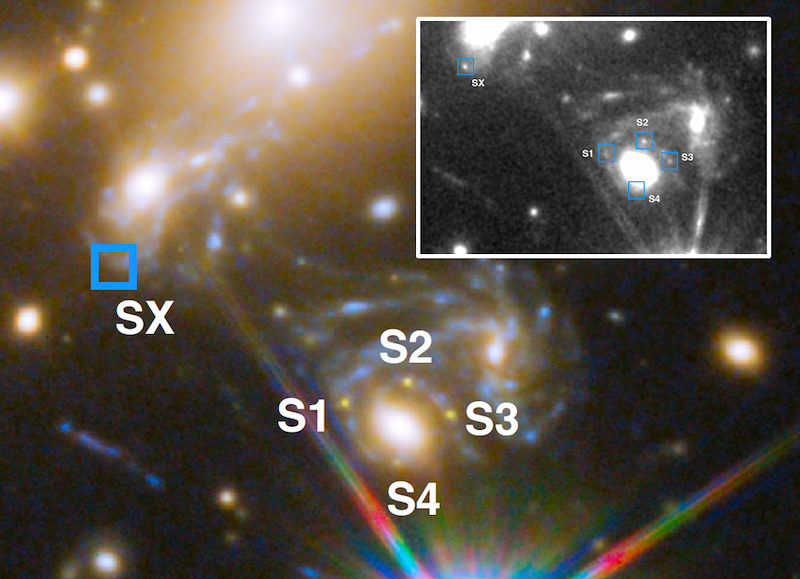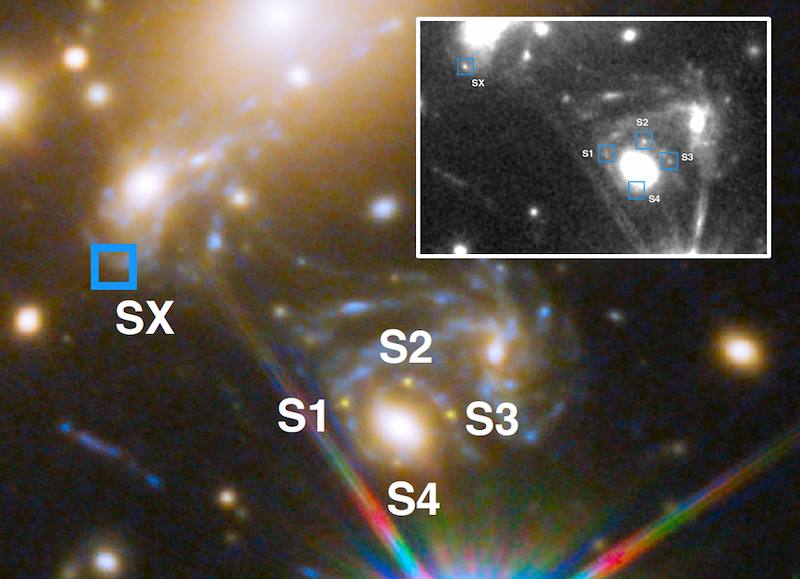Measuring Cosmic Expansion with a Lensed Supernova
This year marks the 100th anniversary of Edwin Hubble’s observation of a pulsating star called a Cepheid variable in the Andromeda nebula. The star was surprisingly faint, implying that it was very far away and that Andromeda must be a separate galaxy—the first evidence that our Milky Way is not alone. Hubble went on to uncover other galaxies and found that they were all moving away from us—a cosmic expansion characterized by the so-called Hubble constant. Astronomers have now used another star, an exploding supernova whose light was bent as it traveled to Earth, to probe the expansion [1]. By determining a time delay between different images of the supernova, the team has recovered a value of the Hubble constant that is lower than estimates based on Cepheids and on other distance markers. However, the error bars are large for the new measurement, so astronomers will need more observations to make lensed supernovae a precision speed check on cosmic expansion.
A lensed supernova is created by the light-bending power of gravity. When a supernova is behind a galaxy, relative to Earth, the light from the exploding star gets curved around the galaxy by the galaxy’s gravity. This action both distorts the star’s image and magnifies it, just like a magnifying glass. Sometimes this lensing can produce multiple images of the star, with each appearing at a different point in the sky. The light from such a set of images travels to Earth along different paths, and so arrives at Earth at different times. In 1964, the astronomer Sjur Refsdal proposed using the time delays to measure the Hubble constant. But detecting a multi-imaged supernova has proved tricky.
Luck finally came 50 years after Refsdal’s proposal. In a Hubble space telescope image from December 2014, Patrick Kelly, then at the University of California, Berkeley, and now at the University of Minnesota, spotted four lensed images of the same supernova [2]. The team was unable to determine the exact time delays between these images, but from previous observations of this part of the sky, Kelly and his colleagues predicted that a fifth image was on the way. This expectation was based on the spotted supernova sitting behind a galaxy cluster, rather than a single galaxy, so the supernova light had multiple paths to reach Earth. The astronomers kept a steady watch, and sure enough the fifth image appeared in December 2015, roughly 376 days after the other four images. This long time delay, which was caused by the cluster’s large mass density, was a boon to the cosmic expansion measurement. “It’s advantageous to have a year-long delay, because the value of the Hubble constant is inversely proportional to the time delay,” Kelly says.
But the time delay alone is insufficient to determine the Hubble constant. Astronomers also need to trace out the exact paths that the supernova light takes on its way to Earth. For that tracing, they use models of the distribution of mass within the galaxy cluster. But much of that mass lies in unobservable dark matter, so the outputs of the models don’t all agree. To circumvent this issue, Kelly and his colleagues evaluated the models’ predictions of the relative brightness of successive supernova images and of the location of the most recently arrived image. Based on that evaluation, they came up with a best-fit model of the mass distribution, which they used to obtain a Hubble constant of 65 km/s/Mpc, where Mpc stands for megaparsec. The error bar is around 4 km/s/Mpc, or 6%.
Cosmologists would like new ways to measure the Hubble constant, as the results of the two most-established methods disagree. The first method—which follows in the footsteps of Hubble’s work from a century ago—uses Cepheids and other well-characterized objects, such as masers and type 1a supernovae, to measure cosmic distances. “Hubble would be amazed to see that we are still using Cepheids,” says physics Nobel laureate Adam Riess from Johns Hopkins University in Maryland. Riess and his colleagues have used such cosmic-distance measurements to determine a Hubble constant of 73 km/s/Mpc with a 1% precision. This measurement disagrees with another method based on the cosmic microwave background, which found 67 km/s/Mpc. This 9% discrepancy is known as the Hubble tension, and it remains a major puzzle (see Feature: Cosmologists Can’t Agree on the Hubble Constant).
The lensed supernova result of Kelly and colleagues is at the low end of the Hubble tension range. But the error bars are large enough that the value agrees with the other two. “I don’t think [the lensed supernova measurement] says anything significant about the Hubble constant at this point,” Riess says.
One way to shrink the error bars on the new Hubble estimate would be to improve the models of the mass distribution in the cluster that lensed the observed supernova light. Kelly says that future measurements by the JWST (the Hubble telescope’s successor) could help in mapping the cluster’s mass. There’s also the anticipation of more lensed supernovae observations. Just recently, astronomers detected a different lensed supernova with JWST. “I’m pretty bullish on that supernova yielding something interesting,” Kelly says. Future surveys, such as those planned for the Rubin Observatory in Chile in the next few years, should also uncover hundreds more lensed supernovae, says Sherry Suyu from the Max Planck Institute for Astrophysics in Germany. “Lensed supernovae have been very rare until now,” Suyu says. “We are entering an exciting era with lensed supernovae!”
–Michael Schirber
Michael Schirber is a Corresponding Editor for Physics Magazine based in Lyon, France.
References
- P. L. Kelly et al., “Constraints on the Hubble constant from Supernova Refsdal’s reappearance,” Science (2023).
- P. L. Kelly et al., “Multiple images of a highly magnified supernova formed by an early-type cluster galaxy lens,” Science 347, 1123 (2015).





